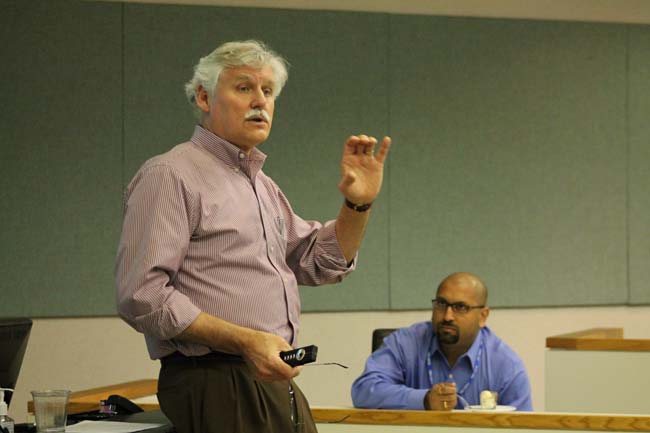
John Gallagher
When John P. Gallagher came to the Duke University Fuqua School of Business, Clint Eastwood was saying, “Go ahead, make my day.” Swatch watches were hip, as were break dancing, Hall & Oates, and Dallas. Times have changed and so has the climate for the Executive MBA—and Gallagher has been at Fuqua to watch and guide it all.
Gallagher helped establish Duke’s Global and Cross Continent MBA programs in 1996. In 2000, he left Fuqua for a brief stint as Vice President of Duke’s Corporate Education program. He came back in 2005 as Fuqua’s Associate Dean of Executive MBA Programs. Gallagher has seen the boom of the American economy send fully funded executive MBA students to Fuqua in droves. He has also watched as EMBA budgets at companies dried up in 2008 and 2009. Now he leads a three-headed beast of EMBA programs—offering potential students a smorgasbord of executive degree programs.
His team has navigated an uncertain and hesitant applicant pool by creating programs that attempt to meet the needs and timing of nearly every applicant. The Cross Continent MBA is a program designed to give younger talent acceleration in their careers. It only requires three years of working experience, takes 16 months to finish and sends students from their homes to five different locations around the globe.
The Global Executive MBA combines the global nature of the Cross Continent program and industry-specific expertise by giving seasoned professionals with at least 10 years of work experience the opportunity to hone in skills in five different concentration areas. If those two programs are not conducive to a busy schedule, Fuqua also offers a 19-month weekend program for professionals with at least five years of experience.
Gallagher and Fuqua have used the diversity of programs coupled with a developing career management office and well-established health sector management certificate program to fend off pesky competitors. In a robust interview with Poets&Quants, Gallagher posits why face-to-face connections will keep EMBA programs from fully succumbing to purely online degrees and discusses the evolving social contract between employees and employers as well as other EMBA market trends.
Poets&Quants: What is Duke doing in the space that is new and different?
Gallagher: Probably the biggest shift is the trend away from a strong focus on general management. Now there is more of a need to demonstrate deeper disciplinary strengths. Students want to pull off career shifts and changes. Today, the majority of students also are paying their own way. They are using the degree to create change in their careers instead of staying in the same spots.
In the middle of our program, we survey students about their interest in career shifts. The questions are fairly detailed about what their goals are and if they are the same as when they came into the program. Five years ago, the number of change in interest was well under 10%. That percentage has risen to around 20 to 25% showing interest in changing their career objective while they are in the program. That makes us believe there are a lot more students coming into EMBA programs who are open to different career options.
We think there are a couple of factors for this. First, this is a shared intense experience with a cohort of people. They interact a lot and probably start thinking about their own careers and career advancement. They are being exposed to one another and learning about the different possibilities out there. Another big part of it is confidence building. That happens when you are halfway through this program. Students start to realize they are capable of things they never thought they were capable of.
We have also redesigned the curriculum in an effort to make room for formal instruction in leadership. That specific academic course helps students do a great deal of reflection about understanding themselves, how they relate to others, and their specific leadership styles. They create a personal development plan and work with an executive coach. Our career management center has introduced a series of optional workshops that are very well attended.
P&Q: How is new technology impacting Duke’s Program?
Gallagher: We introduced our first hybrid model in 1996. It was a very technology enabled and supported model. Obviously, technology has improved and allowed us to do a better job. The primary thing technology has allowed us to do is concentrate and focus the time we have together. We can make classroom time more effective, valuable, and rich. It has created a shift on what people do in the classroom away from information transmission and more into the “what does it mean” activities. It is a more productive use of classroom time.
For instance, our programs are very team oriented. About half of the work is in a team format. Some times not everyone in a team is geographically centrally located. So they have access to video and audio conferencing. They have an integrated calendar that allows them to schedule group meetings and project timelines in a shared environment that integrates with the overall program calendar. They see their own team deliverables. Each student sees a different calendar based on team and program activities. They have access to document sharing. They can share screens and turn control of their keyboards over to someone else so they can work on spreadsheets or other documents on each other’s computers. They are able to record team meetings so if a team member cannot attend a session, he can view that meeting later.
I have been here for 32 years. Before there was a considerable amount of time spent explaining and lecturing. Now the students are learning the underlying concepts outside of the classroom and can use the time to apply those concepts by doing cases in the class with each other.





Questions about this article? Email us or leave a comment below.